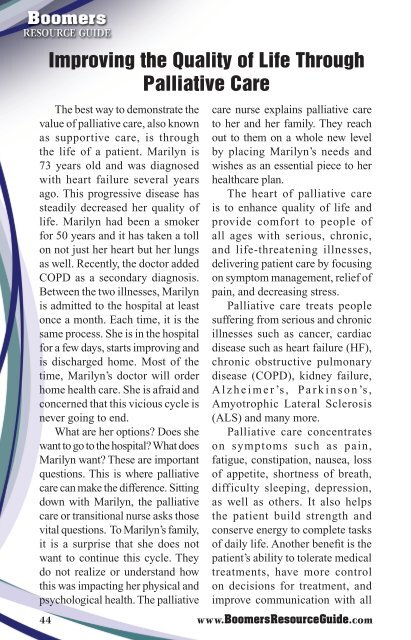Health Services - Senior Citizen's Guide
Health Services - Senior Citizen's Guide
Health Services - Senior Citizen's Guide
Create successful ePaper yourself
Turn your PDF publications into a flip-book with our unique Google optimized e-Paper software.
Improving the Quality of Life Through<br />
Palliative Care<br />
The best way to demonstrate the<br />
value of palliative care, also known<br />
as supportive care, is through<br />
the life of a patient. Marilyn is<br />
73 years old and was diagnosed<br />
with heart failure several years<br />
ago. This progressive disease has<br />
steadily decreased her quality of<br />
life. Marilyn had been a smoker<br />
for 50 years and it has taken a toll<br />
on not just her heart but her lungs<br />
as well. Recently, the doctor added<br />
COPD as a secondary diagnosis.<br />
Between the two illnesses, Marilyn<br />
is admitted to the hospital at least<br />
once a month. Each time, it is the<br />
same process. She is in the hospital<br />
for a few days, starts improving and<br />
is discharged home. Most of the<br />
time, Marilyn’s doctor will order<br />
home health care. She is afraid and<br />
concerned that this vicious cycle is<br />
never going to end.<br />
What are her options? Does she<br />
want to go to the hospital? What does<br />
Marilyn want? These are important<br />
questions. This is where palliative<br />
care can make the difference. Sitting<br />
down with Marilyn, the palliative<br />
care or transitional nurse asks those<br />
vital questions. To Marilyn’s family,<br />
it is a surprise that she does not<br />
want to continue this cycle. They<br />
do not realize or understand how<br />
this was impacting her physical and<br />
psychological health. The palliative<br />
care nurse explains palliative care<br />
to her and her family. They reach<br />
out to them on a whole new level<br />
by placing Marilyn’s needs and<br />
wishes as an essential piece to her<br />
healthcare plan.<br />
The heart of palliative care<br />
is to enhance quality of life and<br />
provide comfort to people of<br />
all ages with serious, chronic,<br />
and life-threatening illnesses,<br />
delivering patient care by focusing<br />
on symptom management, relief of<br />
pain, and decreasing stress.<br />
Palliative care treats people<br />
suffering from serious and chronic<br />
illnesses such as cancer, cardiac<br />
disease such as heart failure (HF),<br />
chronic obstructive pulmonary<br />
disease (COPD), kidney failure,<br />
Alzheimer’s, Parkinson’s,<br />
Amyotrophic Lateral Sclerosis<br />
(ALS) and many more.<br />
Palliative care concentrates<br />
on symptoms such as pain,<br />
fatigue, constipation, nausea, loss<br />
of appetite, shortness of breath,<br />
difficulty sleeping, depression,<br />
as well as others. It also helps<br />
the patient build strength and<br />
conserve energy to complete tasks<br />
of daily life. Another benefit is the<br />
patient’s ability to tolerate medical<br />
treatments, have more control<br />
on decisions for treatment, and<br />
improve communication with all<br />
44 www.BoomersResource<strong>Guide</strong>.com


